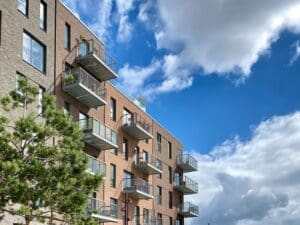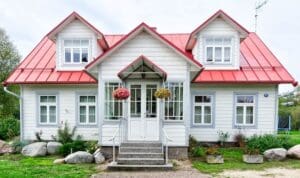If you live in Albany you know how expensive rent can be.
Being a low-income individual in Albany can mean dealing with additional financial stresses, such as finding affordable housing.
Fortunately, there is low-income housing available to those that meet the requirements.
In this article, we will discuss the following elements about low-income housing:
· Defining low-income housing
· Requirements for low-income housing
· How low-income apartments work
· How to apply for low-income housing in Albany, NY
· The Albany Housing Authority
· Finding low-income apartments in Albany
Continue reading to learn more about low-income housing works and how you can apply for it in Albany, NY.
What is low-income housing?
First, let’s dive into defining what low-income housing is. Low-income housing is also known as affordable housing or public housing. Public housing was created to provide decent and safe rental housing for eligible low-income families, the elderly, and persons with disabilities. Public housing is established by the U.S. Department of Housing and Urban Development (HUD).
HUD provides federal funding to local housing agencies (HAs). HAs then used this aid for the management of housing for low-income residents at rates they can afford. Housing types can include apartments, townhouses, or single-family homes.
Sometimes the government will provide federal aid to property owners so that they can provide low-rent apartments. This is an example of privately-owned subsidized housing. With this form of low-income housing, you may have other requirements set by the property owner that you’ll have to meet.
There are two categories that HUD to define your income limits, or the Area Median Income (AMI). To be defined as a “low-income” household, your median family income must be below 80 percent for your area. Those that fall into the “very low-income” category are below 50 percent of the median family income for their area. These categorizations are subject to change based on an area that has substantially high or low incomes.
It is to be noted that income limits can vary from one HA to another, so be sure to check with your local HA to find out their requirements.

Requirements for low-income housing
Listed below are the eligibility requirements by HUD to be considered for low-income housing:
· Annual gross income (income limits within your county or metropolitan area)
· Are elderly, disabled, or a family
· U.S. Citizenship or eligible immigrant status
· Be at least 18 years or older
· Pass a criminal background check
· Provide previous rental history
While these requirements are the basis for HUD, your HA may have additional eligibility requirements you will need to adhere to.
If you are deemed eligible for low-income housing, your HA will then contact your current and previous landlords and may visit you at your current house to determine whether you are a suitable tent candidate. (Source)
How do low-income apartments work?
We will now look into the different low-income housing types and how they operate.
HUD apartments
These types of apartments are managed by HUD which means that they are federally funded. HUD public housing is limited to those who have low-income families, are disabled, or elderly. If interested in HUD housing, applicants would need to contact their local Public Housing Agency (PHA). The link can be found here for applying to HUD public housing.
Section 8 apartments
Also known as the housing choice voucher program, Section 8 is considered the federal government’s main program for assisting low-income families, the disabled, and the elderly to afford decent, safe, and sanitary housing in the private market. Housing assistance with Section 8 is given on behalf of you or your family.
With Section 8 housing, you will have your choice in choosing your ideal housing, as long as it meets the requirements of the program. You will not be limited to choosing a place in a subsidized housing project.
Participants in Section 8 public housing programs are given housing choice vouchers by PHAs who are given funds by HUD. If your family receives this voucher, you have the responsibility in finding housing suitable. The owner of the housing must be willing to agree to the rental requirements under the program. If it meets the standards of the program and the property owner agrees, your family can stay in your current residence.
Once your living situation is confirmed, a housing subsidy will be paid directly to your landlord by your local PHA on your behalf. You and your family would then pay the remaining amount that is not being covered by the PHA. There are certain situations in which the voucher can be used to purchase a home if approved by your PHA.

Scattered Public housing apartments
Scattered public housing apartments are a form of public housing under HUD. This program involves HUD purchasing properties in certain areas where a housing project may not be ideal. This can include duplexes, singles, or small multis. This situation typically happens when a PHA has a large household that needs a more appropriate-sized home to meet their needs. Large low-income households which may not be available in public housing projects.
Benefits of scattered housing include the following:
· Increased engagement with the community: Public housing participants feel a stronger sense of community at a scattered-site and are more willing to engage with their neighbors.
· Decreases poverty: Scattered sites allow for more diversity in a community’s demographics and lessens the concentration of low-income households into one area.
· Blending into the existing neighborhood: Contractors can build low-income houses that fit with the rest of the neighborhood so that the “project-type” housing is not too obvious.
In scattered public housing apartments, you may have to pay for your utilities, as well as paying for a security deposit at move-in. Listed below are additional requirements for the form of public housing.
· Must be a family of two or more that can meet both the minimum and maximum income requirements
· Adults in the household must pass a criminal background check
· Cannot have any debts to present or past landlords
· Cannot owe money to any assisted housing program
Your household may end up on a waiting list depending on how many scattered sites are available in your PHA’s area.
Non-profit senior and family low-income apartments
Section 202 Supportive housing for the Elderly is a public low-income housing provided to senior citizens with very low income and high dependency (need assistance to do necessities such as cooking, cleaning, etc.). This program was created by HUD in which they provide interest-free capital advances to private, nonprofit sponsors to finance the development of supportive housing for the elderly. While senior citizens don’t directly apply for this program, organizations that want funding to create housing for low income elderly must meet the eligibility requirements.
Eligibility requirements for Section 202 public housing are the following:
· Be at least 62 years or older
· No marital status requirements
· Income typically has to be 50 percent below your area’s median income
· Your geographic location (can apply outside of your county or metropolitan area)
· No disability or health requirements
Section 202 public housing includes:
· Meal preparation
· Transportation services
· Housecleaning
To find Section 202 housing, reach out to your local PHA to find out what housing is available in your area. It is to be noted that this form of housing is in high demand, so waiting lists may be in place. Those with high dependency needs and/or debilitating medical conditions will have higher priority for Section 202 housing.
Take the following steps to apply for Section 202 public housing:
1) Ensure that you or your family member meet the program’s eligibility requirements.
2) Begin searching for assisted or independent living facilities near your area. You can use HUD’s housing locator here. There are options to receive free assistance in finding the ideal housing that you can find online.
3) Once you have found a place, contact the property owner to confirm that they accept housing vouchers or participate in public housing programs.
4) See if they are any units available and if there is a waiting list.
Project Rental Assistance Contracts is rental assistance provided by HUD that makes up the difference between what the elderly residents are required to pay and the costs of upkeeping for a particular development.
There are nonprofit assisted living communities provided under public housing. Nonprofit housing means that any profit the assisted living facilities makes once everything is paid will go back to the facility. No money is given to anyone else other than to the facility’s needs. Non-profit assisted living facilities are hard to come by as most are for-profit.
Benefits of non-profit assisted living are listed below:
· No religious affiliation
· Smaller facilities
· Opportunity to develop stronger relationships with fellow senior residents
Unfortunately, if you have Medicare, they typically won’t provide coverage for assisted living costs. That is regardless of whether you choose a non-profit or for-profit facility. Medicaid beneficiaries are also unlikely to receive coverage for these types of facilities as well. You’ll need to look into other ways to pay for housing, such as using a life insurance policy.
Because some non-profit assisted living facilities are backed by a charitable organization, you may be provided with financial aid. You’ll need to research these facilities to see if they can help you with finances.
Veterans’ benefits can be applied to your assisted living costs if you are a veteran. Contact the Department of Veterans Affairs to see if you are eligible for financial assistance.
Family Low-Income Apartments
If you have a family needing assistance getting public housing, please refer to the first section which details the eligibility requirements. Contact your local PHA to get an application to apply for housing.
Low-income tax credit apartments (LIHTC)
The Low-Income Housing Tax Credit (LIHTC) program was created in 1986 to develop more affordable public housing apartments that incentivize property owners by offering them tax incentives. These tax credits allow property owners to list apartments at prices lower than typical market prices. LIHTC program does not provide housing subsidies. Property owners can then have a tiered structure in which some residents pay the regular price for rent and others who pay a reduced rate due to being low-income.
Being eligible for LIHTC apartments aligns with the basic requirements for obtaining housing assistance. When you’re ready to apply, you’ll need to contact the apartment complex directly to receive an application.

How do I apply for low-income housing in Albany, NY?
If you’re living or planning to live in Albany, NY, continue reading to learn about the steps needed to apply for low-income housing.
1) Meet public housing requirements for Albany: Aside from the basic requirements for getting housing assistance, make sure that you meet the income limits, which can be found here.
2) Contact the Albany PHA (Albany Housing Authority): Your best contact will be the Albany Housing Authority. They will be able to answer any questions or concerns you may have directly. You can send them a message here or call them at (518)641-7500.
3) Submit an application: There are a variety of ways you can apply for Albany housing assistance. There is an online application you can view here, or you can mail or fax a paper copy to the following address:
Albany Housing Authority
200 South Pearl ST
Albany, NY 12202
4) Wait for a reply: Depending on how many applicants there are at the time you apply, there is a possibility that you may experience a long waiting period or be put on a waiting list. Updates on your application status will be sent to you via mail.
If you are approved, you would then proceed through the process of finding housing that accepts low-income residents and get that property’s application. It is to be noted that even though the Albany Housing Authority approves your application, a property owner can still deny you if you don’t meet their requirements.
What is Albany Housing Authority (AHA)?
The Albany Housing Authority (AHA) is a PHA located in Albany, NY that provides housing assistance and services to qualifying residents.
AHA’s official website is albanyhousing.org. The following services are provided through the website.
· Applying for housing
· Requesting maintenance services
· Searching apartment listings
· Learning about housing voucher and housing programs
· Contact information for AHA
· Career services
AHA provides four types of public housing programs and vouchers. You can view the programs by clicking on the links below.
Housing Choice Vouchers (Section 8)
This is part of the federally funded HUD program that subsidizes rents for low-income households. Low-income families must pay 30-40 percent of their monthly earnings for rent. AHA’s eligibility requirements include families that make no more than 50 percent of the Albany median income and be either a U.S. citizen or have eligible immigration status.
Project-Based Vouchers (PBV) Program
This is a program quite similar to the Housing Choice Voucher Program, but the main difference is that with PBV, AHA is not given additional funds for privately-owned rental housing. Families have to use 30 percent of their monthly income to pay for rent. Eligibility requirements are the same as the Section 8 Program. To get an application, you will need to contact the properties directly. View this link to get more information about PBV.
Special Purpose Vouchers
These vouchers are federally funded and provided by Congress. To get this voucher, you must meet the specific eligibility requirements, as each program has its own rules and regulations. Click on the program to be redirected to a link that’ll provide you with a thorough description of each voucher program.
· Conversion Vouchers (Tenant Protection & Enhanced Vouchers)
Where are the apartments for low-income residents located in Albany?
The AHA website provides a listing of Albany apartments that are offered to low-income families that qualify for public housing. AHA provides public housing in the following communities listed below. Listed with each community is the contact information you’ll need.
· Academy Lofts
Mike Rimmer, Asset Manager
59 North Swan ST
(518)380-5579
· Administration Building
(518)641-7500
· Arbor Hill Homes
Mike Rimmer, Asset Manager
59 North Swan ST
(518)380-5591
· Capital South Properties
Jillian Wilkinson, Asset Manager
34 Morton Avenue
(518)380-5571
· Capital Woods
Crystal Turner, Asset Manager
200 Lark Drive
(518)380-5591
· Creighton Storey Homes
Steve Iarossi, Senior Asset Manager
158 Third Avenue
(518)380-5551
· Eagle Court Apartments
Jillian Wilkinson, Asset Manager
34 Morton Avenue
(518)380-5571
· Ezra Prentice Homes
Mike Rimmer, Asset Manager
625 South Pearl ST
(518)380-5551
· Ida Yarbrough Homes
Joseph Kessler, Asset Manager
270 North Pearl ST
(518)380-5591
· Jared Holt Mews
Mike Rimmer, Asset Manager
34 Morton Avenue
(518)380-5571
· Lincoln Square Homes
Jillian Wilkinson, Asset Manager
34 Morton Avenue
(518)380-5571
· North Albany Homes
Marrk Edmonds, Asset Manager
41 Jennings Drive
(518)380-5591
· Nutgrove Garden Apartments
Aaron Tannatta, Senior Asset Manager
601 Nutgrove Lane
(518)380-5551
· Ontario/ Sherman
Mike Rimmer, Asset Manager
305 Colonie ST
(518)380-5591
· Pieter Schuyler Court
Mike Rimmer, Asset Manager
305 Colonie ST
(518)380-5591
· Robbery Whalen Homes
Mark Edmonds, Asset Manager
305 Colonie ST
(518)380-5591
· Steamboat Square Homes
Yvonne Hughes, Asset Manager
220 Green ST
(518)380-5551
· Townsend Park Homes
Aaron Tannatta, Asset Manager
45 Central Avenue
(518)380-5571
· Westview Homes
Michelle Citone, Asset Manager
680 Central Avenue
(518)380-5571
Conclusion
Applying for housing can be tedious for many, especially if it is for public housing. Luckily, there are tons of resources you can access before you begin the application process. As long as you meet the eligibility requirements for both the AHA and the property owner and can avoid being waitlisted, you may find yourself in your ideal apartment in Albany.
Share This Article
